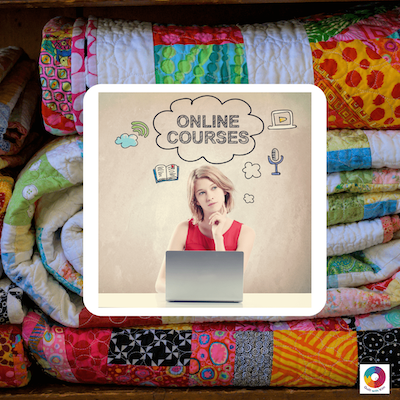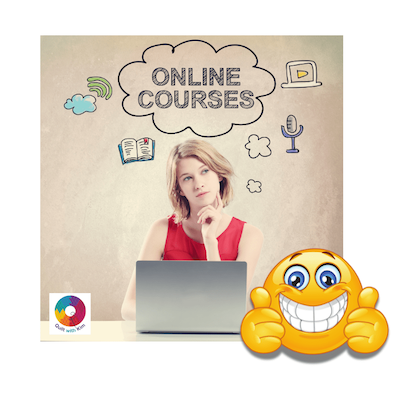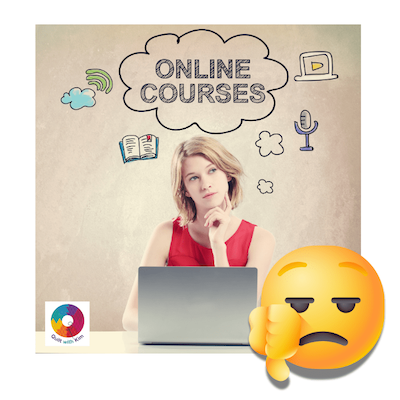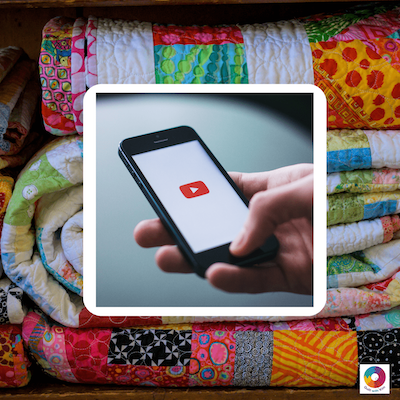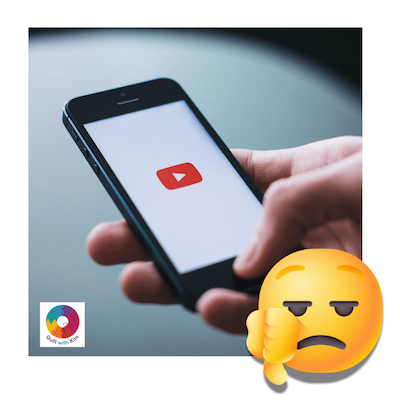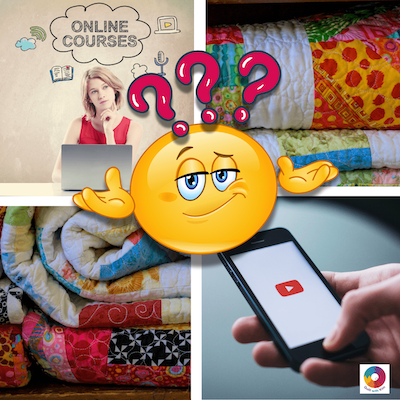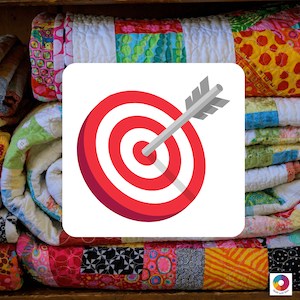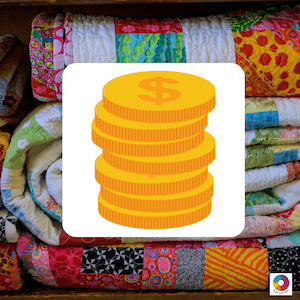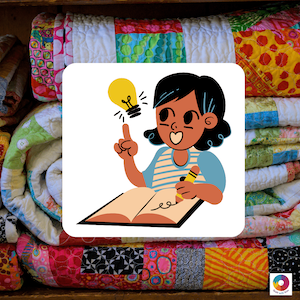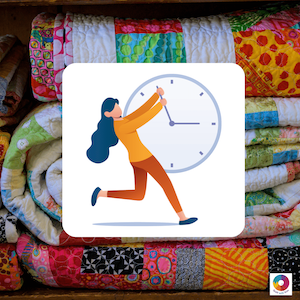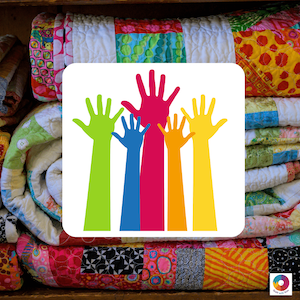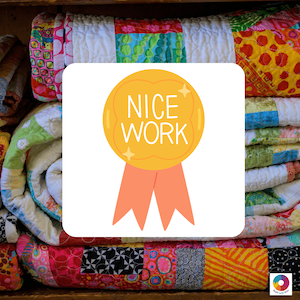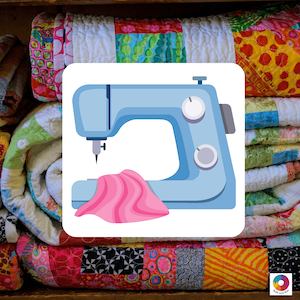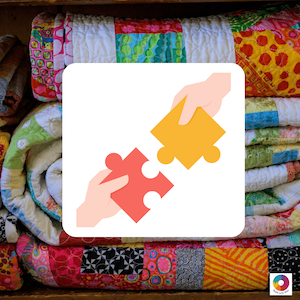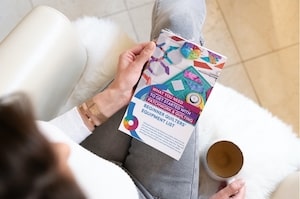First up though:
Learning a new skill like quilting can feel overwhelming without guidance. Online quilting courses are carefully structured to help you build your skills progressively. You'll start with the basics, like fabric selection and accurate cutting, and move on to more advanced techniques, all in a logical order. This structure gets rid of the guesswork, ensuring you don't miss any crucial steps.
For example, if you're learning how to piece a quilt, an online course might dedicate individual lessons to choosing fabric colours, cutting and using your rotary cutter, arranging, pinning, and stitching, so you can focus on one step at a time without feeling rushed.
2. In-Depth Content
Unlike YouTube tutorials, which often focus on quick tips or specific projects, online quilting courses go deeper into the craft. You'll gain a thorough understanding of techniques, troubleshooting tips, and even the "why" behind certain methods.
In my courses, for example, I provide step-by-step video lessons along with detailed written downloadable guides that include photos or illustrations. This dual approach caters to different learning styles, ensuring you grasp even the trickiest concepts.
3. Learn at Your Own Pace
One of the biggest advantages of online courses is flexibility. You can access lessons whenever it suits you and revisit them as often as needed. If you're stuck on a particular technique, you can rewatch the relevant video as many times as you like, without feeling pressured to keep up with others.
This is especially valuable if you have a busy schedule or prefer learning in short bursts. With lessons broken into manageable segments, you can make progress even if you only have 15 minutes to spare.
4. Support and Community
Many online quilting courses include access to the instructor and a community of fellow quilters. This creates a supportive environment where you can:
• Ask questions directly to your teacher.
• Share photos of your progress for feedback.
• Connect with others who share your passion for quilting.
For instance, in my courses, I'm always available to answer student questions. Whether you need help troubleshooting a tricky seam or just want encouragement, you'll never feel like you're learning alone.
5. Lifetime Access and Progress Tracking
Most online quilting courses offer lifetime access, meaning you can return to the materials anytime. This is ideal if you want to revisit a specific technique or start a new project inspired by what you've learned. Many platforms also save your progress, so you can pick up right where you left off without hunting for your place.
6. Professional Instruction
Creating an online quilting course requires significant effort and expertise. Instructors often have years of experience, professional training, or teaching qualifications. This ensures the lessons are well-organised, clear, and effective. By investing in a course, you're investing in guidance from someone who is deeply committed to your success.
This is all well and great, but there are some challenges to learning quilting with online courses. Let's have a look at what these are:
The tutorials are typically created by passionate quilters who enjoy sharing their skills and often feature diverse teaching styles and approaches.
YouTube's global platform means you can explore techniques from creators around the world, providing endless inspiration and opportunities to learn at your own pace.
1. Free and Accessible
The biggest plus of YouTube tutorials is that they're completely free. Whether you're on a budget or just starting your quilting journey, this is a cost-effective way to learn new skills without any financial commitment.
2. Endless Variety
YouTube is a treasure trove of quilting content. From piecing techniques to machine maintenance, there's a tutorial for every aspect of quilting. The variety of instructors also means you can try out different teaching styles and find one that you like.
This is particularly helpful if you're exploring a specific style or project. Want to learn English paper piecing? There's a tutorial for that. Curious about modern quilting patterns? You'll find plenty of inspiration for that too.
3. Instant Gratification
If you need a quick answer to a specific question, YouTube is your best friend. Simply type in your query, and you'll likely find a tutorial addressing it. For example, my most-viewed video helps viewers troubleshoot a sewing machine issue in just a few minutes.
This immediacy makes YouTube perfect for solving problems on the fly or learning small skills as needed.
4. Accessible Anytime, Any Place, Anywhere
YouTube is incredibly flexible when it comes to devices. Whether you're watching on your smartphone, tablet, computer, or TV, you can access tutorials wherever you are. This makes it easy to learn in the comfort of your sewing space or on the go.
5. Cultural and Stylistic Diversity
Quilting is a global craft, and YouTube showcases techniques from quilters worldwide. This diversity introduces you to different approaches, traditions, and design ideas, broadening your perspective and inspiring your creativity.
6. Inspiration and Exploration
Sometimes, you don't know what you want to make until you see it. YouTube is perfect for sparking new ideas and exploring techniques you might not have considered. From scrolling Shorts to discovering hidden gems in suggested videos, inspiration is just a click away.
7. Trial and Error with No Pressure
Because YouTube is free, there's no risk in trying out a new technique or project. If a tutorial doesn't work for you, you can simply move on to another without feeling like you've wasted time or money.
8. Accessibility Across Languages
YouTube's auto-translation and subtitle features make tutorials accessible to a global audience. Even if English isn't your first language, you can often follow along with translated captions or dubbed versions, opening up a world of resources.
Just like the online quilting courses, there are some challenges with YouTube tutorials though, so let's have a look at these:
1. Identify Your Quilting Goals
• Are you looking to build a solid foundation of skills and techniques step by step?
→ An online quilting course is ideal because it provides a structured learning path designed for you to progress.
• Do you have a specific project in mind or want to learn a single skill quickly?
→ A YouTube tutorial might be more practical to answer your immediate question/needs.
If you're new to quilting and feel unsure about where to start, an online course can give you the confidence and clarity you need to begin your journey.
2. Think About Your Budget
• If you're ready to invest in your hobby and value premium content, an online quilting course is worth considering. Think of it as an investment in yourself: structured, high-quality content that can save you time and frustration.
Tip: Many instructors offer free or low-cost introductory lessons, which can help you gauge whether a course is a good fit for you without breaking the bank.
3. How Do You Like To Learn?
• Do you thrive on clear, step-by-step instructions with access to additional support?
→ Opt for an online course, where lessons are thoughtfully organised and you can ask questions if needed.
• Do you enjoy figuring things out independently, experimenting, and exploring various techniques?
→ Stick with YouTube tutorials, which give you the freedom to learn on your own terms.
Think about how you like to learn: Are you someone who enjoys ticking off steps and tracking progress, or do you prefer hopping between topics based on inspiration?
4. How Much Time Do You Have Available?
• If you have a busy schedule and can only spare a few minutes here and there, YouTube tutorials are great for quick learning sessions.
• If you're willing and wanting to dedicate time to learning and mastering quilting at a deeper level, an online course will provide the guidance and structure you need to make consistent progress.
Tip: Online courses often allow you to learn at your own pace, so you don't need to rush through the material. You can spread lessons out over weeks or months to fit your schedule.
5. Think About the Level of Support You Need
• If you value personalised guidance and the ability to ask questions, choose an online course. Many courses include direct access to the instructor or a community of fellow quilters.
• If you're comfortable learning solo and don't need additional help, YouTube tutorials provide plenty of information without the expectation of interaction.
In my online quilting courses, students can send me photos of their progress for feedback or ask questions if they get stuck. This level of support ensures no one feels lost or overwhelmed.
6. Consider Your Personality and Motivation
• If you're highly motivated and can stay on track without external accountability, YouTube tutorials might work well for you.
• If you like having someone cheer you on and holding you accountable, an online course will keep you focused and help you stay motivated.
7. Choose the Option depending on the Project
• For larger, more complex projects that require precision and skill-building, an online course provides the depth and detail necessary to succeed.
• For smaller, one-off projects or quick fixes, YouTube tutorials offer the fast solutions you need.
8. Don't Be Afraid to Combine Both
• Use YouTube tutorials to explore new ideas, troubleshoot problems, try specific techniques or find the teacher that's right for them.
• Turn to an online quilting course when you're ready to learn more comprehensively and build your skills step by step.
For example:
If you're just starting your quilting journey, free YouTube tutorials are a great way to explore the basics and get a feel for the craft. You might start with a search for "beginner quilting tutorials" and watch a few videos to learn essential skills like cutting fabric or sewing a straight seam.
These tutorials help you figure out which parts of quilting excite you and where you might need more guidance, like piecing blocks or mastering quilt binding.
After experimenting with a few small projects, you realise that while YouTube has been a helpful introduction, the lack of structure is making it hard to progress confidently. To take the next step, you decide to enrol in an online quilting course.
This gives you a clear, step-by-step path to build your skills without worrying about missing any key techniques. With this structured approach, you can refine your craft and start tackling more ambitious projects.
Example Two:
Let's say you're a complete beginner, and quilting feels a bit overwhelming. You decide to start by exploring YouTube tutorials to get an idea of what's out there.
While browsing, you come across a teacher whose style you really enjoy: maybe they explain things clearly, take their time, and focus on the details that matter.
After watching a few videos, you realise that while the tutorials are helpful, the sheer volume of content on YouTube makes it hard to know where to start or what steps to follow next. To avoid missing any important techniques, you decide to join that teacher's online quilting course.
This way, you get the best of both worlds: the teacher you trust, plus a structured, step-by-step path to guide you. No more guessing or worrying if you've overlooked a crucial skill!
By combining YouTube for exploration and an online course for focused learning, you're setting yourself up for quilting success without feeling overwhelmed.
Do either of these examples sound like you?
I hope that helps, and Happy Quilting!
Kim
x
Kim also hosts a popular YouTube channel, Quilt With Kim, where she shares tutorials and tips tailored to beginners. She has also taught patchwork live on air on Sewing Street on TV.
Based in Gloucestershire, UK, Kim enjoys yoga, cooking, and seaside and country walks with her husband, Nige. Her chief quilting assistant, Shadow the cat, is always on hand to supervise her projects.
Download the free guide, "What You Need to Get Started With Quilting," to join Kim's newsletter list and begin your quilting journey today.
Download your FREE copy today.
PLUS comes with handy print out shopping guide!


